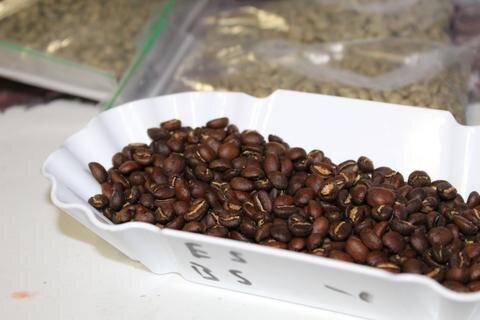Where does coffee come from? If this is a question you’ve ever asked yourself in terms of roasting then we hope this blog will provide you with some answers. This blog is the third in our series describing the journey coffee takes to get from the farm to your cup. Hopefully we’re able to provide some insight into the coffee roasting process.
Coffee roasting is a complicated operation as it is both scientific and intuitive at the same time. It utilizes precise measurements and readings whilst at the same time involving estimation and guesswork. It is important to note that while there are fundamental principles of roasting to follow, each roaster will have his own personal philosophy when it comes to certain aspects. At Baba Java we believe in roasting our coffee to accentuate and develop the natural flavors that are within our beans. We avoid stifling the taste in our coffee by roasting it too light or dark. Instead, we specifically source our green coffee, sample it, and roast medium in order to achieve maximum taste.

The goal of roasting coffee is to develop the natural acidic flavors by roasting it long enough without roasting it so long that it burns. The best way to keep the flavor of coffee developing without burning it is through convection heat (hot air). That is why the design of one’s roaster is so important. Most roasters are designed to maximize convection heat and minimize conduction heat. Some loft the beans in a continuous upward stream of hot air (fluid bed roasters), while some utilize movement of the roaster itself. Such examples include both centrifugal roasters, which spin quickly, heating the beans as they go, as well as a drum roaster, which lays on its side and spins to keep the beans aloft.
Baba Java’s coffee roaster operates with a double walled drum made of cast iron and uses natural gas as the heating source. It’ll utilize indirect heat and incorporate the double walled drum to ensure the spread of heat evenly. It constantly turns which tumbles the beans around to provide a balanced roast throughout This also means that the coffee is roasted via convection rather than conduction. Airflow will be going in and out of the drum in order to regulate the temperature and provide that convection roasting.
The temperature control is the main focus whilst roasting. The drum will be heated to a specific temperature, as per the roast profile, once the green coffee is added the temperature will drop. It will then begin to rise once the temperature of the drum and the beans meet an equilibrium. After this, the primary goal is to ensure that the rate of rise is steady and increasing. Avoiding dramatic jumps up in temperature, plateaus and (most importantly) drops in temperature. The roaster itself has mechanisms in place that monitor and control airflow in and out in order to maintain a steadily increasing rate of rise. Lowering or raising the gas setting is the other means of controlling the rate of rise. This is done very rarely, however, and only at specific times of a roast.
There are a large number of variables which all play a factor when roasting coffee. The type and size of the machine being used, the coffee’s origin, and the processing method are some of the more general examples. Some variables involve roast philosophy or preference such as the amount of coffee used for a roast and desired roast length (i.e. light, medium or dark). When you get down to the minor details the list gets longer with gas setting/changes to gas setting, airflow, starting temperature and second phase among others all playing a part in the taste of the coffee. Determining what all these factors need to be in order to achieve the best results is where you get into what’s called roast profiling.

Through sample roasting on a smaller scale, we are able to figure out the ideal roast profile for our origins before translating it over to the larger roaster. Profiling is difficult because you are dealing with a constantly changing product, as the coffee beans age, their structure will start to deteriorate slowly over time. Proper storage in special bags designed for storing organic product in a climate-controlled area will aid to keep the aging process as slow as possible. This does mean, however, that you need to alter your profile to account for this aging and to ensure you’re able to maintain the desired flavours. If we find our product to have dipped in quality then we must experiment with the profile in order to bring it back up. This makes it seem like two sides of the same coin with one side being that once a roast profile is set it must be followed exactly to ensure a consistent result. However, on the other hand, no profile is permanent and needs to be adjusted when necessary.
As you can see, even the basic concepts of roasting can be difficult to master; however, practice makes perfect and we have had the benefit of roasting many kinds of coffee since before we were open. Though the basic concepts do not change, roasting is a fun and exciting challenge that yields an even better result- a delicious cup of coffee.

